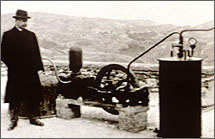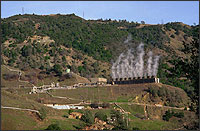A History of Geothermal Energy in the United States

First geothermal power plant, 1904, Lardarello, Italy.
Archaeological evidence shows that the first human use of geothermal resources in North America occurred more than 10,000 years ago with the settlement of Paleo-Indians at hot springs. The springs served as a source of warmth and cleansing, their minerals as a source of healing. While people still soak in shallow pools heated by the Earth, engineers are developing technologies that will allow us to probe more than 10 miles below the Earth's surface in search of geothermal energy. We invite you to study the timeline of the recent history of geothermal energy in the United States.
Important Events in the History of Geothermal Energy in the United States
Human beings have used geothermal energy in North America for at least 10,000 years. Paleo-Indians used hot springs for cooking, and for refuge and respite. Hot springs were neutral zones where members of warring nations would bathe together in peace. Native Americans have a history with every major hot spring in the United States.
1800 - 1850
1807
As European settlers moved westward across the continent, they gravitated toward these springs of warmth and vitality. In 1807, the first European to visit the Yellowstone area, John Colter, probably encountered hot springs, leading to the designation "Colter's Hell". Also in 1807, settlers founded the city of Hot Springs, Arkansas, where, in 1830, Asa Thompson charged one dollar each for the use of three spring-fed baths in a wooden tub, and the first known commercial use of geothermal energy occurred.
1847
William Bell Elliot, a member of John C. Fremont's survey party, stumbles upon a steaming valley just north of what is now San Francisco, California. Elliot calls the area The Geysers-a misnomer-and thinks he has found the gates of Hell.
1851 - 1900
1852
The Geysers is developed into a spa called The Geysers Resort Hotel. Guests include J. Pierpont Morgan, Ulysses S. Grant, Theodore Roosevelt, and Mark Twain.
1862
At springs located southeast of The Geysers, businessman Sam Brannan pours an estimated half million dollars into an extravagant development dubbed "Calistoga," replete with hotel, bathhouses, skating pavilion, and racetrack. Brannan's was one of many spas reminiscent of those of Europe.
1864
Homes and dwellings have been built near springs through the millennia to take advantage of the natural heat of these geothermal springs, but the construction of the Hot Lake Hotel near La Grande, Oregon, marks the first time that the energy from hot springs is used on a large scale.
1892
Folks in Boise, Idaho, feel the heat of the world's first district heating system as water is piped from hot springs to town buildings. Within a few years, the system is serving 200 homes and 40 downtown businesses. Today, there are four district heating systems in Boise that provide heat to over 5 million square feet of residential, business, and governmental space. Although no one imitated this system for some 70 years, there are now 17 district heating systems in the United States and dozens more around the world.
1900
Hot springs water is piped to homes in Klamath Falls, Oregon.
1901 - 1950
1921
John D. Grant drills a well at The Geysers with the intention of generating electricity. This effort is unsuccessful, but one year later Grant meets with success across the valley at another site, and the United States' first geothermal power plant goes into operation. Grant uses steam from the first well to build a second well, and, several wells later, the operation is producing 250 kilowatts, enough electricity to light the buildings and streets at the resort. The plant, however, is not competitive with other sources of power, and it soon falls into disuse.
Hot Springs National Park in Arkansas is created.
1927
Pioneer Development Company drills the first exploratory wells at Imperial Valley, California.
1930
The first commercial greenhouse use of geothermal energy is undertaken in Boise, Idaho. The operation uses a 1000-foot well drilled in 1926. In Klamath Falls, Charlie Lieb develops the first downhole heat exchanger (DHE) to heat his house. Today, more than 500 DHEs are in use around the country.
1940
The first residential space heating in Nevada begins in the Moana area in Reno.
1948
Geothermal technology moves east when Professor Carl Nielsen of Ohio State University develops the first ground-source heat pump, for use at his residence. J.D. Krocker, an engineer in Portland, Oregon, pioneers the first commercial building use of a groundwater heat pump.
1951 - 1960

A geothermal power plant at The Geysers.
1960
The country's first large-scale geothermal electricity-generating plant begins operation. Pacific Gas and Electric operates the plant, located at The Geysers. The first turbine produces 11 megawatts (MW) of net power and operates successfully for more than 30 years. Today, 69 generating facilities are in operation at 18 resource sites around the country.
1961 - 1970
1970
The Geothermal Resources Council is formed to encourage development of geothermal resources worldwide.
The Geothermal Steam Act is enacted, which provides the Secretary of the Interior with the authority to lease public lands and other federal lands for geothermal exploration and development in an environmentally sound manner.
1971 - 1980
1972
The Geothermal Energy Association is formed. The association includes U.S. companies that develop geothermal resources worldwide for electrical power generation and direct-heat uses.
1973
The National Science Foundation becomes the lead agency for federal geothermal programs.
1974
The U.S. government enacts the Geothermal Energy Research, Development and Demonstration (RD&D) Act, instituting the Geothermal Loan Guaranty Program, which provides investment security to public and private sectors using developing technologies to exploit geothermal resources.
1975
The Energy Research and Development Administration (ERDA) is formed. The Division of Geothermal Energy takes over the RD&D program. The Geo-Heat Center is formed. The center, located at the Oregon Institute of Technology, disseminates information to potential users and conducts applied research on using low- to moderate-temperature geothermal resources. The U.S. Geological Survey releases the first national geothermal resource estimate and inventory.
1977
The U.S. Department of Energy (DOE) is formed.
1978
The Public Utility Regulatory Policies Act (PURPA) is enacted. PURPA encourages the development of independent, nonutility cogeneration and small power projects by requiring electric utilities to interconnect with them. The act results in the development of several water-dominated resources.
Geothermal Food Processors, Inc., opens the first geothermal food-processing (crop-drying) plant in Brady Hot Springs, Nevada. The Loan Guaranty Program provides $3.5 million for the facility.
A hot dry rock geothermal facility is created and tested in Fenton Hill, New Mexico, with financial assistance from DOE. The facility generates electricity two years later, in 1980.
1979
The first electrical development of a water-dominated geothermal resource occurs, at the East Mesa field in the Imperial Valley in California. The plant is named for B.C. McCabe, the geothermal pioneer who, with his Magma Power Company, did field development work at several sites, including The Geysers.
DOE institutes funding of direct-use demonstration projects. Among the beneficiaries of this effort are several office buildings, district heating systems, and agribusinesses.
1980
TAD's Enterprises of Nevada pioneers the use of geothermal energy for the cooking, distilling, and drying processes associated with alcohol fuels production. UNOCAL builds the country's first flash plant, generating 10 MW at Brawley, California.
1981 - 1990
1981
With a supporting loan from DOE, Ormat successfully demonstrates binary technology in the Imperial Valley of California. This project establishes the technical feasibility of larger-scale commercial binary power plants. The project is so successful that Ormat repays the loan within a year.
The first electricity is generated from geothermal resources in Hawaii. The Department of Energy demonstrates the production of electricity from moderate temperature geothermal resources using binary technology at Raft River, ID.
1982
Economical electrical generation begins at California's Salton Sea geothermal field through the use of crystallizer-clarifier technology. The technology resulted from a government/industry effort to manage the high-salinity brines at the site.
1984
A 20-MW plant begins generating power at Utah's Roosevelt Hot Springs. Nevada's first geothermal electricity is generated when a 1.3-MW binary power plant begins operation.
The Heber dual-flash power plant goes online in the Imperial Valley of California with 50 MW.
1987
Geothermal fluids are used in the first geothermal-enhanced heap leaching project for gold recovery, near Round Mountain, Nevada.
1989
The world's first hybrid (organic Rankine/gas engine) geopressure-geothermal power plant begins operation at Pleasant Bayou, Texas, using both the heat and the methane of a geopressured resource.
1991 - 2000
1991
The Bonneville Power Administration selects three sites in the Pacific Northwest for geothermal demonstration projects.
1992
Electrical generation begins at the 25-MW geothermal plant in the Puna field of Hawaii.
1993
A 23-MW binary power plant is completed at Steamboat Springs, Nevada.
1994
DOE creates two industry/government collaborative efforts to promote the use of geothermal energy to reduce greenhouse gas emissions. One effort is directed toward the accelerated development of geothermal resources for electric power generation; the other is aimed toward the accelerated use of geothermal heat pumps.
1995
Integrated Ingredients dedicates a food-dehydration facility that processes 15 million pounds of dried onions and garlic per year at Empire, Nevada. A DOE low-temperature resource assessment of 10 western states identifies nearly 9000 thermal wells and springs and 271 communities collocated with a geothermal resource greater than 50ºC.
2000
DOE initiates its GeoPowering the West program to encourage development of geothermal resources in the western U. S. An initial group of 21 partnerships with industry is funded to develop new technologies.
2001 - 2002
2001
GeoPowering the West brings together representatives from industry and agencies such as the U.S. Bureau of Land Management and U.S. Forest Service to identify major barriers to geothermal development in the west. The report of the proceedings listed specific action items and recommendations. Several of the recommendations pertained to leasing, permitting, and access to federal lands.
Secretary of the Interior Gail Norton convened a renewable energy summit with officials from DOI, DOE, and other agencies to identify actions required to support renewable energy development. Recommendations specific to geothermal emerged from the meeting, including a mandate to BLM to accelerate issuing leases and permits on federal lands.
2002
Organized by GeoPowering the West, geothermal development working groups are active in five states — Nevada, Idaho, New Mexico, Oregon, and Washington. Group members represent all stakeholder organizations. The working groups are identifying barriers to geothermal development in their state, and bringing together all interested parties to arrive at mutually beneficial solutions.
2003
2003 The Utah Geothermal Working Group is formed.
Our thanks to the Geo-Heat Center for providing substantial information about the history of geothermal energy.


















